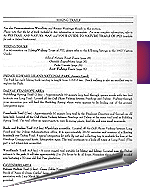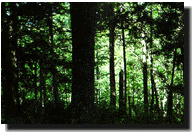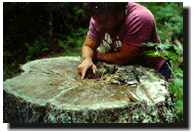

Prince Edward Island’s forests cover approximately 48 percent of the total land surface. All of our forested areas have been harvested at least once. Island forests were cleared for agriculture, fuel wood, the lumber trade, and shipbuilding. Indeed, by the turn of the twentieth century, over 75 percent of the forest had been cleared and the land converted to farming. In many cases, cutters harvested the best trees and left the poorer quality ones to regenerate. As a result, most Prince Edward Island forests are not of the hardy quality and diversity that characterize the scattered remnants of old growth native forest. The original Acadian forest contained a large proportion of hardwood deciduous trees, including beech, sugar maple, yellow birch, and red oak. Common softwood conifers included fir, spruce, larch, white cedar, white birch, hemlock, and the majestic white pine. Although forestry practices are a hot topic of public concern today, over-harvesting was more of a problem in 1935, when only 32.4 percent of the land was forested.
 Today, Prince Edward
Island’s forest industry is seeing great demand for
its wood products. The Island supplies North American
markets with construction-grade lumber and pulpwood. Many
environmental associations have expressed concern about
forestry practices and private land management issues.
According to the Round Table report on Resource Land Use
and Stewardship, the public wishes to see controls on
clearcutting, (which can destroy fish habitat and is
aesthetically unsightly), wood utilization, and the
conversion of plantations to blueberry or other
agricultural production. Furthermore, increases in
replanting have not kept pace with increases in
harvesting.
Today, Prince Edward
Island’s forest industry is seeing great demand for
its wood products. The Island supplies North American
markets with construction-grade lumber and pulpwood. Many
environmental associations have expressed concern about
forestry practices and private land management issues.
According to the Round Table report on Resource Land Use
and Stewardship, the public wishes to see controls on
clearcutting, (which can destroy fish habitat and is
aesthetically unsightly), wood utilization, and the
conversion of plantations to blueberry or other
agricultural production. Furthermore, increases in
replanting have not kept pace with increases in
harvesting. The fate of softwood (conifers) is of significant concern; current levels of harvest cannot be sustained. In fact, the estimated sustainable level of harvest is expected to drop from the present 300,000 cubic metres to 125,000 cubic metres in roughly 15 years. Softwoods are under great harvesting pressure and are subject to premature mortality. This problem is believed to be caused by soil infertility, poor tree genetics, or the inability of the soil to retain moisture. Mixed woods are under little pressure, compared to the mid-1980s, during the energy crisis, when wood heating was a popular alternative to fossil fuel reliant heating systems. Total hardwood harvest is currently considered to be at sustainable levels.

In 1997, the forest industry developed a voluntary Code of Practice for Forest Contractors that sets out standards and guidelines that might contribute to the long-term health of the forest, protecting immature stands, plantations, and thinnings. The protection of streams and watercourses is also provided for with guidelines for buffer strips. Although participation is voluntary, only contractors abiding by the Code are permitted to work on Crown Land.
The Round Table Report on Resource Land Use and Stewardship suggests imposing softwood harvesting controls, which would promote appropriate reforestation. Such measures might include issuing harvesting permits to control the areas of harvest, imposing a quota system to control the level of harvest, offering property tax incentives for sustainable woodlot management, and establishing a regulated code of practice to ensure that environmental standards are respected.
Erosion | Soil Conservation | Ground Water Quality
Surface Water Quality | Natural Disasters | Irving Whale